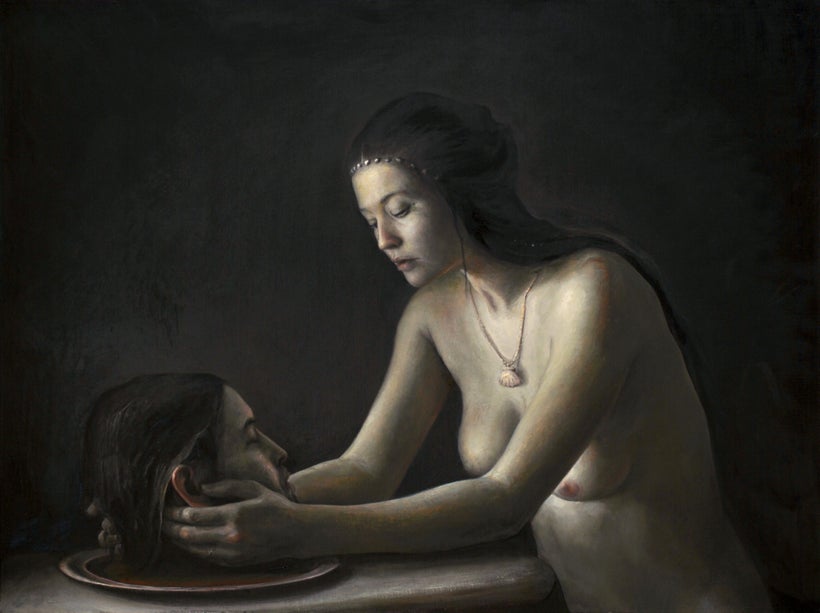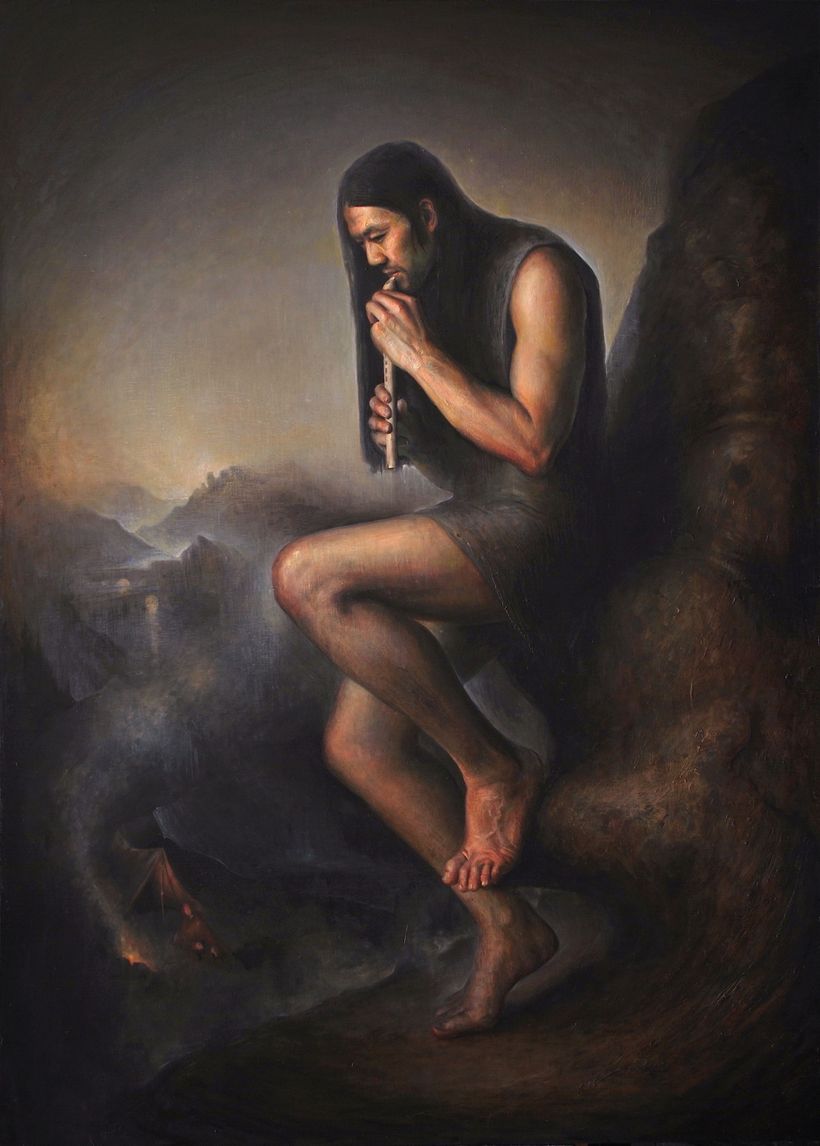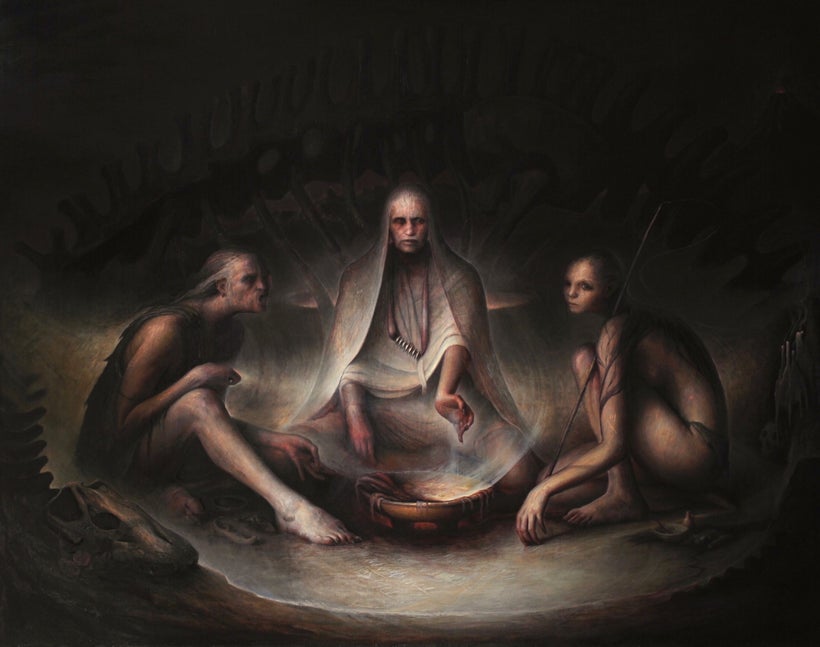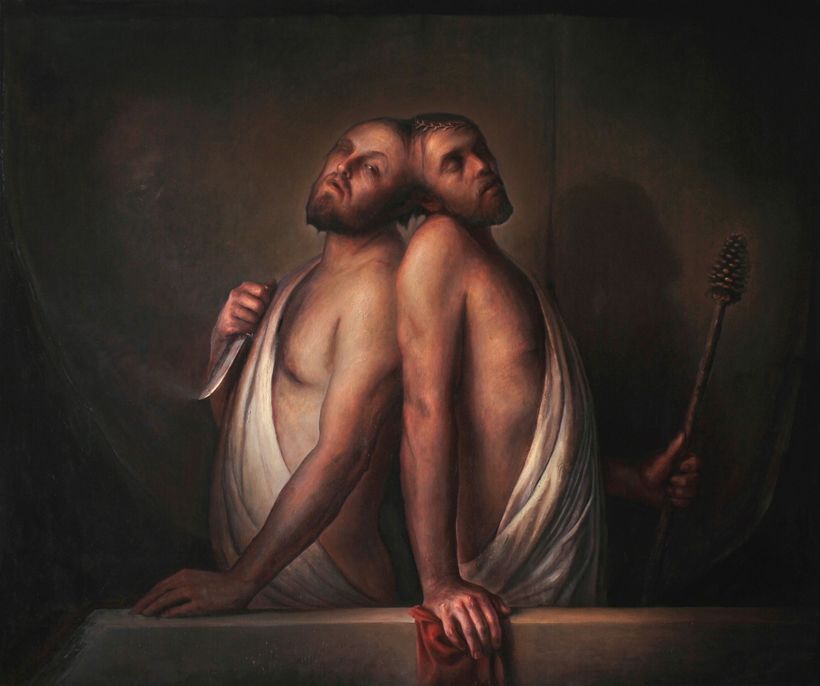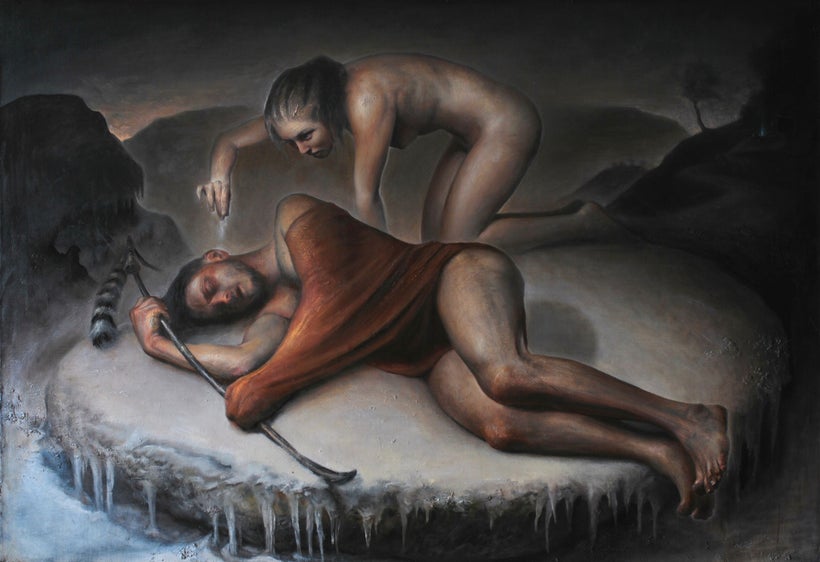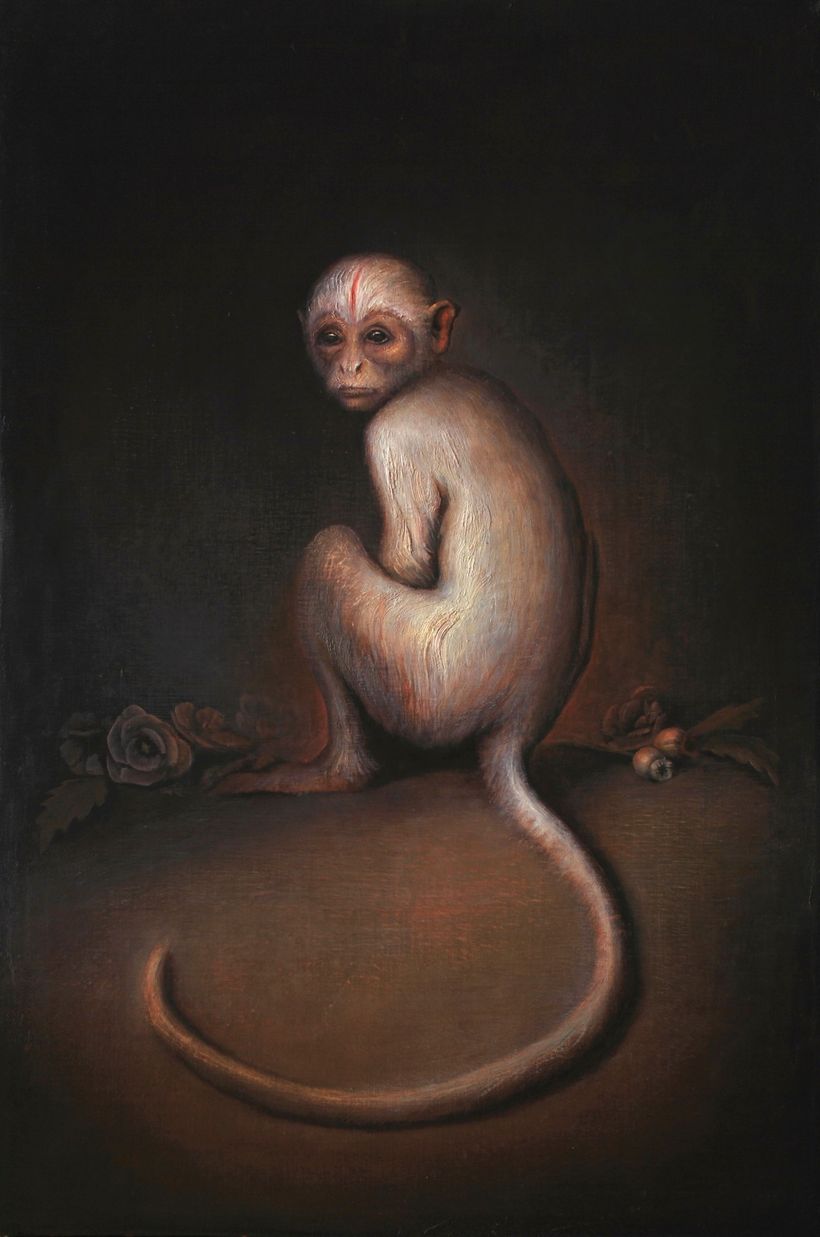LUKE HILLESTAD
Artist Luke Hillestad, whose works were recently on view at the Booth Gallery in New York, paints a world that leaves science behind and fills in the vacant spaces with occult rituals, human tenderness and a dash of weirdness. In Hillestad’s Northern Eden a sense of myth pervades, opening up the unexplored regions between fear and possibility.
John Seed Interviews Luke Hillestad
LUKE HILLESTAD
Can you describe your early life and background and how it shaped you?
I wasn’t allowed to play contact sports because I have a metal heart valve. I was lucky because I loved to draw. My parents were encouraging and showed me how to enter drawing competitions; they usually had a theme or an event to be depicted. One drawing contest won us tickets to the Olympic festival which came to Minnesota. My painting was “A Tae Kwon Do Man Kicking.” I was thrilled when we got to see the great martial artists compete in-person. I remember discovering that the best Tae Kwon Do matches had players who moved theatrically and that the best players would end the match with some dramatic move.
I enjoyed puzzles and liked to invent my own. I kept notebooks with made-up mazes, hidden pictures, hypercubes, and games. A few of my close friends and I invented video games with characters and level designs. Another friend made Brueghel-like pictures. He painted dozens of little people all working, playing, or resting in idyllic landscapes. He could use paint because he was a few years older than me. It was amazing. I received paint and brushes a year later for Christmas.
LUKE HILLESTAD
When did you get serious about painting?
During High School and University I primarily focused on music. I liked to play classical guitar, write for other instruments, and make mythic, sometimes melancholic, love-songs. I remember believing that it would help me woo my girlfriend Michelle. Next we bought a home with savings from my land-surveying job. After life began to feel more steady, I rushed back into painting. The best kind of picture that I could imagine would be a combination of the nature paintings and the video game character illustrations that I saw growing up.
A UCLA geologist, Edward Young, talks about a solar planet named Theia and its collision with the planet Gaia which formed into Earth. I’ve had a few collisions which felt this way; one was meeting Michelle, another was seeing Rembrandt’s “Jewish Bride” in person. A third event was being awe struck upon discovering Odd Nerdrum’s “Two Men Guiding One” at our University’s Weisman Museum. In Nerdrum, I saw a new height for what could be achieved by a living painter. Seeing this higher bar inspired me to work faster towards it. Then, yes, perhaps I became more serious for a while.
LUKE HILLESTAD
Tell me a story or two about what it was like to study with Odd Nerdrum.
When I arrived in Norway, Nerdrum was finishing “The Messenger.” I had seen early shots of it, but now it was even better. Odd handed me a cloth dunked in oil and purple, then he pointed to the painting and said, “would you glaze the sky on this?” I reluctantly agreed. He continued, “then I can sit back like Rubens and watch you do my work for me…” I laughed. Then I dragged the rag across the canvas, filling in the sky area. I carefully avoided crossing the lines of the finished figures. Then I handed the rag back to Odd. He took it, but then blended the glaze from the sky right into parts of the figures. After being surprised, I saw Odd’s way was better. The people in the painting now felt like they were part of the atmosphere.
A few weeks later I started a still-life of an old saw. One day I had been focusing on each metal tooth. Odd walked up beside me. It was at an awkward early stage for him to see it, but I was eager for advice. After a minute he said, “This saw could be on a table, and then behind it could be Michelle, peaking up from behind the table so we can see the top of her face.” I was taken aback. Not only would his suggestion make my painting more difficult to make, it seemed like a joke. Was he hoping I’d do it so he could have a laugh? Nerdrum appeared earnest, but when I pictured his suggestion in my mind, the outcome only looked goofy to me.
REMBRANDT VAN RIJN
Years later we were in the Louvre and I restlessly made my way to the Rembrandt room. I looked at the familiar painting “The Flayed Ox” and studied it within breathing distance. Then I saw her, a woman behind the side of beef, peaking out from the doorway. I immediately remembered Odd’s suggestion about Michelle peaking out from behind the saw on the table. I realized that Rembrandt was probably having fun, a bit like I used to with hidden pictures. More than that, he may have been showing us what was important to him. I also learned that Odd, like myself, borrowed some ideas from his teachers.
LUKE HILLESTAD
If someone says to you: “You are obviously a member of the ‘School of Nerdrum’” how do you respond?
Oh yes, and it becomes all the more obvious when I tell them that I call myself a kitschpainter. Our contemporaries may soon learn that painting “like Odd,” means painting like other greats such as George Frederic Watts, late Titian, Eugène Carrière, and early Munch. My friend used to say, “‘Be like Mike’ means more than sticking your tongue out while you dunk. You have to train yourself like Mike did.” I often see Nerdrum’s work as though “Rodin reincarnated as a painter.” This may help people better understand Nerdrum’s students. We are grateful that, at least, one giant is alive.
We see the history of painters like a landscape of impressive mountains; I am thinking of the Tolkien scene where Gandalf looks out at the mountainscape of beacons. All of my favorite painters have been earnest in a pursuit of something similarly human. Unfortunately, those who are afraid to be seen in the shadow of a giant might not get close enough to hear what the giant is relaying. Our kind, the self-proclaimed students of Nerdrum, do not mind time in the shadows.
LUKE HILLESTAD
Tell me about one of the paintings you are showing at Booth gallery.
At the front of the gallery are the “Weird Sisters.” Here the viewer is positioned as Macbeth before these witches in their meeting. Depending on which version of this play it represents, these three fates are either predicting our future or presumably causing it. It is about will and rites, but it also involves hypnosis. Although, even after all of the time that I spent painting with these three women, I don’t claim to have learned anything real about hypnosis. These figures are on the edge of the world, where the crust is bubbling and the plates are shifting. It is volatile and full of dormant energy where prehistoric beings once lived.
LUKE HILLESTAD
What are some of the major themes in your work at this point?
I want to offer paintings as windows into different archetypes, for instance, a lover, an outlaw, a hero, or a fool. In normal life your connection with these identities may be involuntary. Emotions have a way of whipping around self perception. Character paintings offer us a chance to slowly and voluntarily identify with a still and perhaps unfamiliar archetype. We may feel more like a bystander in front of a painted character, but, either way, we spend some time with the mindset.
A few years ago I painted more pictures of reconciliation and partnership. Right now I am more intrigued by conflict. I’ve been obsessed with conjoined twins. I watched a documentary about twin girls who were conjoined at the head. I remember that one girl hated the taste of catsup and the other girl liked it. When the sister who loved catsup ate some, the taste travelled through her brain into her displeased sister’s taste receptors. The irritated girl was so unhappy she squirmed under the table and her catsup-eating sister fell with her. That blew my mind. I couldn’t wrap my brain around this challenge to my notion that individuality was tied to privacy.
The girls’ inherent lack of privacy necessitated inevitable conflicts which could not be solved by demanding that they each “mind their own business.” I came to understand that this conflict of taste was evidence of disagreeing wills. I then guessed that individuality had more to do with independent will. This gave me the meaning I needed in order to finish my painting “Craniopagus.” Here there are two wills and one body.
After the film showed that the conjoined twin’s could taste each other’s food, I wondered if they could know each other’s thoughts. Seriously. But even if they did, could one know the difference between her own thought and her sister’s? I wondered if any thought she had would feel like her own. I presume that if she questioned whether an idea was shared she could ask her sister, but even if she agreed, who could tell where the thought originated? In fact, far more than they disagreed, the documentary showed the girls being remarkably in touch with each other’s needs and movements. Those girls were amazing. I saw an archetype in the image of two bodies with wills in agreement. This gave me the meaning I needed to finish “The Island.” I was also helped by a number of trips to the Getty Villa.
LUKE HILLESTAD
Do you have any special ways in which you use your media? Any technical secrets you can make public?
Painting techniques are like magic tricks, they aren’t guaranteed to work in every environment, but they are fun to learn. I keep a few rituals in order to avoid the feeling of forced technique. I pace back and forth from the canvas, squint, and look with a mirror while I paint all to help maintain fresh vision. This has much to do with mood and preference. I once saw that Titian got his figures to look like figurines scattered on a shallow stage which receded into the landscape. I was captivated by pursuing that effect. It has something to do with giving the light in a painting the escape routes it needs. Scumbling, sanding, scraping, spraying, glazing, or perhaps, some brushwork may help address this. It is related to seeing that the figures appear to be a part of the atmosphere.
LUKE HILLESTAD
What are your main interests outside of painting?
Politics. I like trying to follow the convoluted narratives in the day to day news. I also mean politics in the classical sense. While I usually paint about personal and interpersonal things, I am still interested in larger social dynamics. I watch to see how conflicts resolve and conclusions are reached. I like watching people. It is strange when thousands are all chanting the same thing. Occasionally, I do find something to learn from an incessant crowd. I do like to watch the politicians, but most of them look unhappy. Though, I suppose, happiness is not the primary reason why one is driven into politics. On the other hand, cultural pursuits seem to be more about the pursuit of happiness, or sadness, or whatever emotion is healthy for your situation.
Luke Hillestad is represented by:
325 West 38th St. Store #1 New York, NY, 10018



